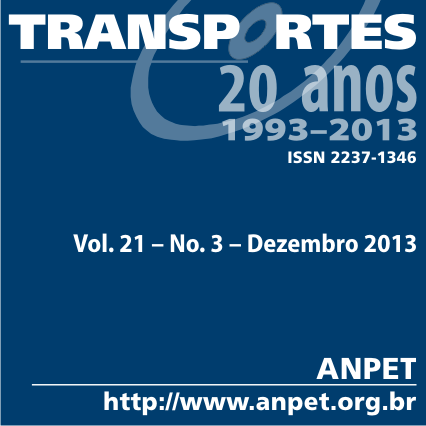MÉTODO PROBABILÍSTICO PARA IDENTIFICAÇÃO DE ZONAS DE ACUMULAÇÃO DE ACIDENTES
DOI:
https://doi.org/10.4237/transportes.v21i3.683Abstract
Neste trabalho apresenta-se um novo método de definição e identificação de zonas de acumulação (ZAA) de acidentes considerando um modelo de regressão binário. Este modelo permite calcular a probabilidade de um local ser ou não ZAA tendo em conta as características geométricas e funcionais do mesmo. Este novo método foi aplicado ao caso das interseções tendo-se, para tal, gerado uma base de dados fictícia considerando as características da sinistralidade e das interseções da cidade do Porto. Através da simulação de dados é possível conhecer a priori as “verdadeiras” ZAA. O desempenho do método foi analisado com base nos erros resultantes da classificação dos locais em ZAA ou não-ZAA, e comparado com dois dos métodos mais aplicados e analisados – o método de ranking pelo número de acidentes e o método Bayesiano-empírico. Desta análise verificou-se que o método binário proposto tem claramente melhor desempenho.
Downloads
References
AASHTO (2010) Highway Safety Manual. American Association of State Highway and Transportation Officials, Washington DC.
ISBN: 978-1-56051-477-0
Cafiso, S. e Silvestro, G. D. (2011) Performance of Safety Indicators in Identification of Black Spots on Two-Lane Rural Roads Transportation Research Record: Journal of the Transportation Research Board, 2237, 78-87.
DOI: 10.3141/2237-09
Cardoso, J. L. (1998) Definição e detecção de zonas de acumulação de acidentes. Segurança Rodoviária - Avaliação e Redução da Sinistralidade, LNEC, Lisboa, 131-133.
Carlin, B. e Louis, T. (2000) Bayes and Empirical Bayes Methods for Data Analysis. Chapman and Hall, London.
ISBN: 1439840954
Cheng, W. e Washington, S. (2008) New Criteria for Evaluating Methods of Identifying Hot Spots. Transportation Research Record: Journal of the Transportation Research Board, 2083, 76-85.
DOI: 10.3141/2083-09
Cheng, W. e Washington, S. P. (2005) Experimental evaluation of hotspot identification methods. Accident Analysis & Prevention, 37, 870-881.
DOI: 10.1016/j.aap.2005.04.015
Elvik, R. (2008) Comparative Analysis of Techniques for Identifying Locations of Hazardous Roads. Transportation Research Record: Journal of the Transportation Research Board, 2083, 72-75.
DOI: 10.3141/2083-08
Ferreira, S. (2010) A Segurança Rodoviária no processo de planeamento de redes de transportes. Ph.D. dissertation, University of Porto.
Fridstrom, L., Ifver, J., Ingebrigtsen, S., Kulmala, R. e Thomsen, L. K. (1995) Measuring the contribution of randomness, exposure, weather and dayligth to the variation in road accident counts. Accident Analysis and Prevention, 27, 1-20.
DOI: 10.1016/0001-4575(94)E0023-E
Geedipally, S. R. e Lord, D. (2010) Identifying Hot Spots by Modeling Single-Vehicle and Multivehicle Crashes Separately Transportation Research Record: Journal of the Transportation Research Board, 2147, 97-104.
DOI: 10.3141/2147-12
Greene, W. H. (2008) Econometric Analysis. Sixth Edition. Pearson International Edition, New Jersey.
ISBN-13:978-0-13-513740-6; ISBN-10:0-13-513740-3
Greibe, P. (2003) Accident prediction models for urban roads. Accident Analysis and Prevention, 35, 273-285. DOI: 10.1016/S0001-4575(02)00005-2
Huang, H. e Haque, H. C. C. M. M. (2009) Empirical Evaluation of Alternative Approaches in Identifying Crash Hot Spots. Naive Ranking, Empirical Bayes, and Full Bayes Methods. Transportation Research Record: Journal of the Transportation Research Board, 2103, 32-41.
DOI: 10.3141/2103-05
Lan, B. e Persaud, B. (2011) Fully Bayesian Approach to Investigate and Evaluate Ranking Criteria for BlackSpot Identification. Transportation Research Record: Journal of the Transportation Research Board, 2237, 117-125.
DOI: 10.3141/2237-13
Lord, D. (2000) The prediction of accidents on digital networks: characteristics and issues related to the application of accident prediction models. Ph.D. dissertation, University of Toronto. http://hdl.handle.net/1807/14514
Lord, D. (2006) Modeling motor vehicle crashes using Poisson-gamma models: examining the effects of low sample mean values and small sample size on the estimation of the fixed dispersion parameter. Accident Analysis and Prevention, 38, 751-766.
DOI: 10.1016/j.aap.2006.02.001
Lord, D. e Persaud, B. N. (2004) Estimating the safety performance of urban road transportation networks. Accident Analysis and Prevention, 36, 609-620.
DOI: 10.1016/S0001-4575(03)00069-1
Miranda-Moreno, L. F., Fu, L., Saccomanno, F. F. e Labbe, A. (2005) Alternative Risk Models for Ranking Locations for Safety Improvement. Transportation Research Record: Journal of the Transportation Research Board, 1908, 1-8.
DOI: 10.3141/1908-01
Montella, A. (2010) A comparative analysis of hotspot identification methods. Accident Analysis and Prevention, 42, 571-581.
DOI: 10.1016/j.aap.2009.09.025
OCDE (1997) Road safety principles and models: review of descriptive, predictive, risk and accident consequence models.Organisation for Economic Co-operation and Development, Paris. http://www.oecd.org/sti/transport/roadtransportresearch/2103285.pdf
Schluter, P. J., Deely, J. J. e Nicholson, A. J. (1997) Ranking and selecting motor vehicle accident sites by using a hierarchical Bayesian model. The Statistician, 46, 293-316.
DOI: 10.1111/1467-9884.00084
Downloads
Published
How to Cite
Issue
Section
License
Authors who submit papers for publication by TRANSPORTES agree to the following terms:
- The authors retain the copyright and grant Transportes the right of first publication of the manuscript, without any financial charge, and waive any other remuneration for its publication by ANPET.
- Upon publication by Transportes, the manuscript is automatically licensed under the Creative Commons License CC BY 4.0 license. This license permits the work to be shared with proper attribution to the authors and its original publication in this journal, and to be adapted for non-commercial purposes, provided appropriate credit is given and any derivative works are distributed under the same terms.
- Authors are authorized to enter into additional separate contracts for the non-exclusive distribution of the version of the manuscript published in this journal (e.g., publishing in an institutional repository or as a book chapter), with recognition of the initial publication in this journal, provided that such a contract does not imply an endorsement of the content of the manuscript or the new medium by ANPET.
- Authors are permitted and encouraged to publish and distribute their work online (e.g., in institutional repositories or on their personal websites) after the editorial process is complete. As Transportes provides open access to all published issues, authors are encouraged to use links to the DOI of their article in these cases.
- Authors guarantee that they have obtained the necessary authorization from their employers for the transfer of rights under this agreement, if these employers hold any copyright over the manuscript. Additionally, authors assume all responsibility for any copyright infringements by these employers, releasing ANPET and Transportes from any responsibility in this regard.
- Authors assume full responsibility for the content of the manuscript, including the necessary and appropriate authorizations for the disclosure of collected data and obtained results, releasing ANPET and Transportes from any responsibility in this regard.









